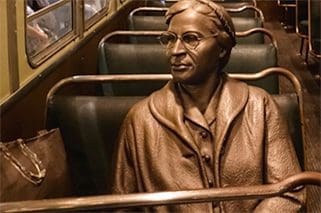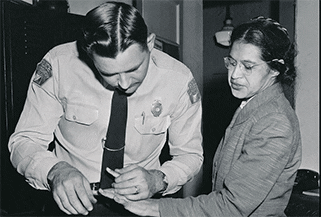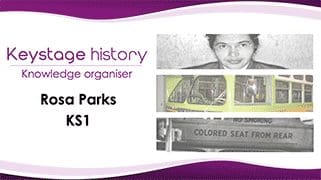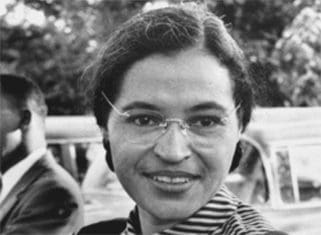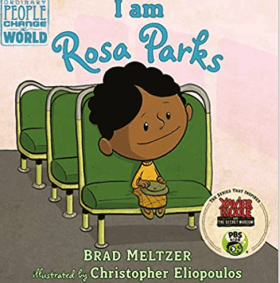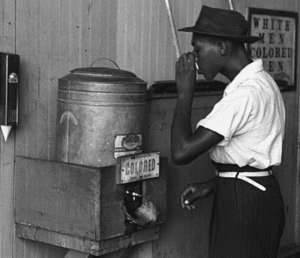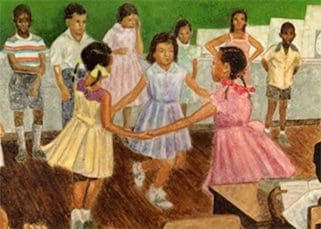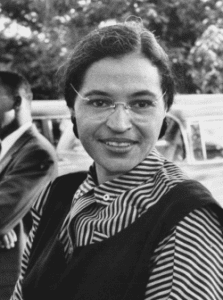 So, we want and certainly can teach about Rosa Parks in KS1, but how shall we do this without falling into simplistic and possibly falsified interpretations? That’s the challenge.
So, we want and certainly can teach about Rosa Parks in KS1, but how shall we do this without falling into simplistic and possibly falsified interpretations? That’s the challenge.
The story of Rosa Parks fits well within an inclusive history curriculum and is probably best suited to treatment in Year 2 where schools are expected to link the significant person with another on linked them, separated in time. The choice is personal. Some schools look at Gandhi others, and this would be my preference, look at Suffragettes. Year 2 pupils can certainly grasp the concept of inequality in society today and will be aware of issues of race and gender, however loosely.
What we don’t want is to make forced comparisons with figures whose life is just too complex to make sense of. I have some reservations about Gandhi for that reason.
So back to Rosa Parks.
She is a significant person for KS1 history and an iconic figure for Black History Month: in her lifetime named ‘Mother of the Civil Rights Movement’, accorded a Congressional Medal in 1999, and one of the very few who has lain in State on Capitol Hill in Washington on her death, as flags throughout the USA flew at half mast. But more than that, this KS1 story soon starts to connect with KS2 thematic study of Black and British and onto KS3 studies of slavery and KS4 explorations of the ending of the British empire and Civil Rights in the USA
This is a great story ripe for the re-telling, the re-enacting and the re-interpreting! As the story goes , a weary 42 year old black seamstress refuses, at the end of a long working day to give up her seat on the bus, in defiance of the Montgomery Race Laws. Her defiance sparks the civil rights movement. She is arrested, the pressure group of which stake up her cause – they have been looking for an appropriate person whose personal life would withstand hostile press. Rosa fitted the bill. So, whether her actions on that day were politically driven and premeditated or not, it did not come out of the blue and Rosa was not just any old seamstress!
So, should we play into the myth of a lone (elderly) Cinderella figure, weary, footsore, limping on to a bus, collapsing on to a seat, only to be shunted off by a rude, racist, white bus driver. Or do we stick with what Rosa herself has insisted – she was no more tired than usual. In her autobiography she wrote:
People always say that I didn’t give up my seat because I was tired, but that isn’t true. I was not tired physically, or no more tired than I usually was at the end of a working day. I was not old, although some people have an image of me as being old then. I was forty- two. No, the only tired I was, was tired of giving in.
Plenty to get our teeth into here then and not too complex as the action on one level takes place on different timescales i.e. the incident on the bus, the year long boycott, the longer Civil right struggle over decades, the long history of segregation and discrimination leading up to this even. So, whether or not pupils can grasp all these timescales, they will certainly be able to make sense of the first two
Be careful though.
When teaching significant people at Ks1 there is a lurking danger off bigging them up just too much, drifting into hagiography as if they were saint-like. Rosa Parks herself was always careful to explain that she did not change things alone. ‘Four decades later’ she said, ‘I am still uncomfortable with the credit given to me for starting the bus boycott. I would like [people] to know I was not the only person involved. I was just one of many who fought for freedom.’
How should we view Rosa’s contribution to Civil Rights now?
So Rosa was not the mother of the Civil Rights Movement, in the sense of its originator; nor did she act alone. In the Bus Boycott she was the figurehead chosen – post hoc – to launch a campaign orchestrated by NAACP and led by Martin Luther King and others. Does her significance boil down to this?
People had been defying the segregated seats regulations on the buses for many years, and had been arrested, including Rosa herself, who had fallen foul of the same bus driver ten years before. So, the Civil Rights movement did not suddenly start with the Montgomery Bus Boycott though this was undoubtedly the first event to hit the headlines in the mid 50s and heralded a campaign that gathered force and legitimacy over the next 15 years.
How should we conclude?
So Rosa was not just a ‘tired seamstress with tired feet’ but a political activist who had been involved in previous discussions about an appropriate opportunity to take segregation to court. She had actually been its secretary and had undertaken a significant amount of much less newsworthy work. She had tried to register to vote on numerous occasions – and failed. The bus gesture was not premeditated, but she was known as a thoroughly reliable activist when they selected her case to start the boycott. This does not in any way detract from what she did.. She didn’t shout, or make a fuss when the driver said he would have her arrested. She just stayed sitting. That took courage and conviction – as well as determination to protest against discrimination.
Planner and knowledge organiser
Subscribers only: You must be logged in to view this content in full. Please
Login or
register 
 So, we want and certainly can teach about Rosa Parks in KS1, but how shall we do this without falling into simplistic and possibly falsified interpretations? That’s the challenge.
So, we want and certainly can teach about Rosa Parks in KS1, but how shall we do this without falling into simplistic and possibly falsified interpretations? That’s the challenge.